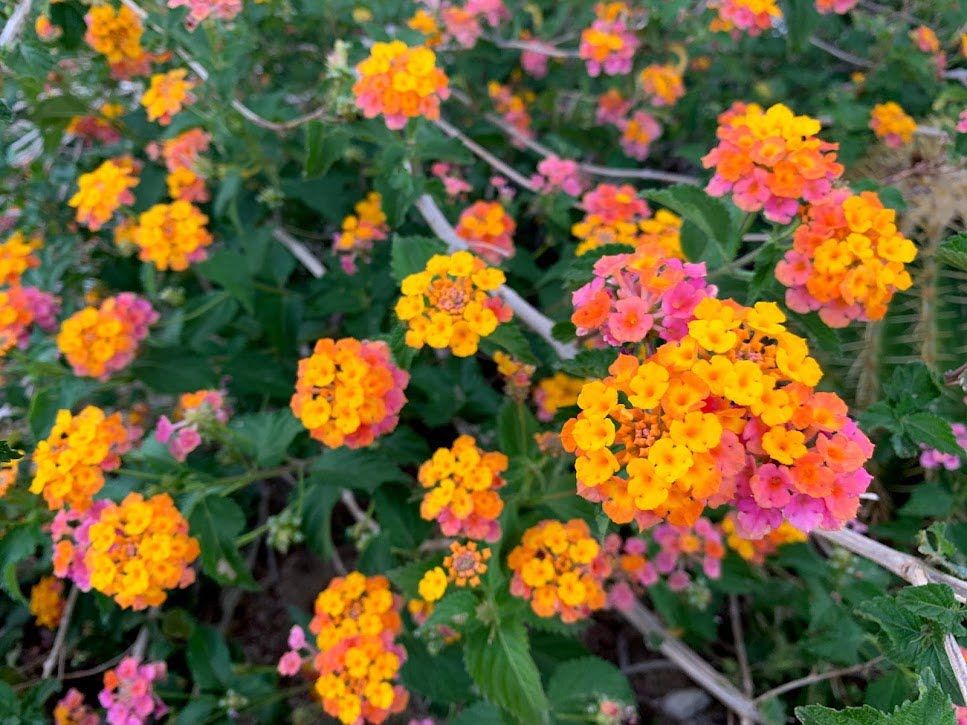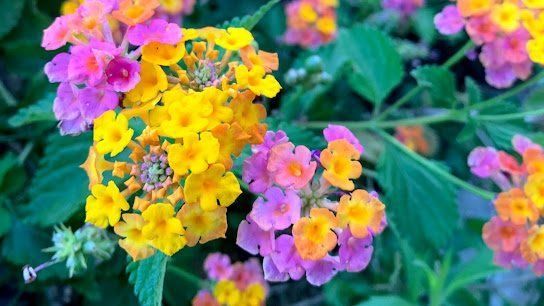Lantana Camara Thrive in Borrego Springs
Share

The Vibrant and Versatile Flower
Lantana Growing Guide and Facts
Common Names
: Shrub Verbana, Ham ‘n’ Eggs. Spanish Flag. Button Sage, Red Sage. Lantana: Weeping; Desert; Brushland; Island; Trailing.
Life Cycle
: Half hardy perennial commonly grown as a half hardy annual by gardeners.
Height
: 20 to 80 inches (50 to 200 cm).
Native
: Tropical regions of Africa and the Americas.
Growing Region
: Zones 6 to 10.
Borrego Springs is known for its stunning desert landscape and unique flora and fauna. One of the most popular and recognizable flowering plants in the area is the Lantana Camara. This vibrant and versatile plant is not only a favorite among gardeners but also attracts a wide range of pollinators and beneficial insects.
Lantana Camara is a tropical plant that is native to South America and West Africa. It prefers full sun and well-draining soil, making it well-suited for arid regions like Borrego Springs. The plant is drought-tolerant and can withstand extreme temperatures, making it a low-maintenance addition to any garden.
Planting Requirements:
The optimum amount of sun or shade each plant needs to thrive: Full Sun (6+ hours), Part Sun (4-6 hours), Full Shade (up to 4 hours).
- Soil: Lantana Camara prefers well-drained soil but can grow in a range of soil types, including sand, loam, and clay.
- Sunlight: Lantana Camara requires full sun to thrive. It is recommended to plant it in an area that receives at least 6 hours of direct sunlight daily.
- Watering: Lantana Camara is drought-tolerant, so it needs little to no supplemental water in the landscape. However, it’s important to water regularly during its establishment phase to help the roots grow and stabilize.
- Fertilizer: Adding compost or fertilizer to the soil during planting can help ensure the best possible growth and performance. Regular fertilization during the growing season can also encourage healthy growth and flowering.
- Spacing: Lantana Camara should be spaced 12 to 24 inches apart to allow for proper growth and air circulation.
- Climate: Lantana Camara is suitable for growing in hardiness zones 9a, 9b, 10a, 10b, 11a, and 11b. In warm winter climates, it becomes a flowering shrub, while in cooler climates, it functions as an annual.
- Pests and Diseases: Lantana Camara is relatively pest-free, but it can be susceptible to whiteflies, aphids, and spider mites. Regular monitoring and treatment, as needed, can help control pests and prevent plant damage.
Lantana Camara: A Colorful, Fragrant, and Easy-to-Care-For Plant
Features:
- Vibrant pink flowers that bloom from planting to frost.
- Sweet-smelling foliage.
- Heat and drought tolerant, making it a low-maintenance option.
- Attracts birds, butterflies, and hummingbirds.
Characteristics:
- Plant Type: Annual.
- Height: Medium, reaching 12 to 26 inches.
- Spacing and Spread: 12 to 24 inches in both.
- Flower and Foliage Colors: Pink flowers and dark green foliage.
- Habit: Mounded.
- Container Role: Thriller.
Plant Needs:
- Light: Requires full sun.
- Maintenance: Easy to care for.
- Bloom Time: Planting to frost.
- Hardiness Zones: Suitable for 9a, 9b, 10a, 10b, 11a, and 11b.
- Water: Average water requirements.
- Uses: Ideal for both landscape and container planting.
Pruning
Lantana For lantana grown as a perennial, pruning is necessary to maintain healthy growth and encourage flowering. Lightly shearing the plant after blooming can promote bushier branches and future blooms. In spring, cut the stems down to 6-12 inches from the ground to promote branching and flowering. If the plant produces berries, pruning after flowering can help keep its aggressive growth in check and prevent seed spread.
Maintenance Notes:
Lantana Camara is a tough and resilient plant that thrives on neglect. It is heat-tolerant, drought-resistant, and can grow in a range of soils. Pruning is optional, but can help shape the plant and promote branching. In warm winter climates, Lantana can become a flowering shrub. However, in some areas, it functions as an annual. Fertilization can help maintain growth and encourage flowering. Please note, Lantana leaves may be toxic to pets, so it’s important to keep them out of reach. The amount of seed set can vary, but deadheading can help with continuous blooming. Regular fertilization will ensure optimal performance.
Types of Lantana
- Trailing Lantana (Lantana montevidensis): Ideal for baskets or hanging displays with branches up to 12 inches in length.
- Popcorn Lantana (Lantana trifolia): Features small and vibrant clusters of flowers.
- Wild Lantana (Lantana urticoides): Found in Texas and characterized by pungent leaves.
- ‘Spreading Sunset’ (Lantana x ‘Monet’): A cultivar with gold-centered flowers surrounded by orange, which later turns pink.
- Lantana camara ‘Miss Huff’: A cold-hardy variety (hardy to Zone 7b) with orange and yellow flowers.
- Lantana camara ‘Bandito’: A compact-growing variety with mounding habit and orange, red, or pink flowers.

Interesting Facts:
- Lantana Camara is also known as West Indian Lantana and Yellow Sage.
- The plant produces clusters of small, brightly colored flowers in shades of yellow, orange, pink, and purple.
- The fragrance of the flowers is sweet and spicy and attracts a variety of pollinators, including butterflies, bees, and hummingbirds.
- Lantana Camara is a member of the Verbenaceae family and is related to other popular herbs like lavender and lemon verbena.
Uses:
In addition to its ornamental value, Lantana Camara has a number of practical uses. It is a popular ingredient in traditional medicine and is used to treat a variety of ailments, including fever and skin irritation. The plant also has insecticidal properties and is used as a natural pest control remedy.
The Dangers of Lantana Camara
- Toxicity: Lantana Camara is toxic to pets, and its leaves can cause a toxic reaction. The Humane Society of America considers it as a poisonous plant for animals.
- Invasive Species: Lantana Camara is considered an invasive species in some areas and can quickly spread, taking over native plant populations. It is essential to monitor its growth and prevent it from spreading to natural habitats.
- Allergic Reactions: Some people may experience skin irritation, itching, and redness after coming into contact with Lantana Camara. In rare cases, it may cause more severe allergic reactions, such as anaphylaxis.
- Fire Hazard: Lantana Camara is flammable and can easily ignite in a wildfire. It is crucial to plant it away from flammable structures and materials to minimize fire risk.
- Poisoning: Ingesting Lantana Camara can cause nausea, vomiting, and diarrhea in humans and animals. If ingested, it is important to seek medical attention immediately.
It’s essential to be aware of the potential dangers of Lantana Camara and take appropriate precautions when planting and handling it. If in doubt, it is recommended to consult with a local expert or the local extension service for advice.
Photo by Willem Labuschagné on Pexels.com
" data-medium-file="https://irp.cdn-website.com/b3751088/dms3rep/multi/pexels-photo-6673079.jpeg?fit=300%2C202&ssl=1" data-large-file="https://irp.cdn-website.com/b3751088/dms3rep/multi/pexels-photo-6673079.jpeg?fit=1000%2C674&ssl=1" src="https://lirp.cdn-website.com/b3751088/dms3rep/multi/opt/pexels-photo-6673079-1920w.jpeg?resize=355%2C239&ssl=1" alt="a butterfly perched on flowers" class="wp-image-5684" width="355" height="239" srcset="https://irp.cdn-website.com/b3751088/dms3rep/multi/pexels-photo-6673079.jpeg?w=1880&ssl=1 1880w, https://irp.cdn-website.com/b3751088/dms3rep/multi/pexels-photo-6673079.jpeg?resize=300%2C202&ssl=1 300w, https://irp.cdn-website.com/b3751088/dms3rep/multi/pexels-photo-6673079.jpeg?resize=1024%2C690&ssl=1 1024w, https://irp.cdn-website.com/b3751088/dms3rep/multi/pexels-photo-6673079.jpeg?resize=768%2C517&ssl=1 768w, https://irp.cdn-website.com/b3751088/dms3rep/multi/pexels-photo-6673079.jpeg?resize=1536%2C1034&ssl=1 1536w, https://irp.cdn-website.com/b3751088/dms3rep/multi/pexels-photo-6673079.jpeg?resize=1200%2C808&ssl=1 1200w, https://irp.cdn-website.com/b3751088/dms3rep/multi/pexels-photo-6673079.jpeg?resize=1400%2C943&ssl=1 1400w, https://irp.cdn-website.com/b3751088/dms3rep/multi/pexels-photo-6673079.jpeg?resize=600%2C404&ssl=1 600w" sizes="(max-width: 355px) 100vw, 355px" data-recalc-dims="1" id="1210113811" onerror="handleImageLoadError(this)"/>Lantana Camara is a beautiful and beneficial plant that is well-suited for Borrego Springs’ arid climate. Whether you are a gardener or simply appreciate the beauty of nature, this vibrant and versatile flower is a must-have in your desert landscape.









